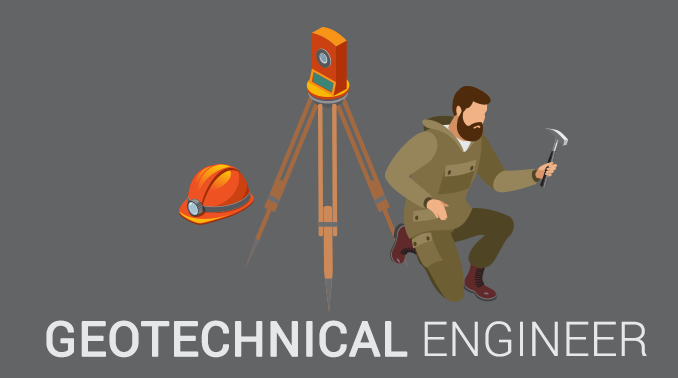Excitement About Geotheta
Excitement About Geotheta
Blog Article
8 Easy Facts About Geotheta Shown
Table of ContentsThe 10-Second Trick For GeothetaLittle Known Facts About Geotheta.A Biased View of GeothetaLittle Known Facts About Geotheta.
They collaborate with civil engineers, architectural engineers, architects, and various other professionals to incorporate geotechnical considerations right into the overall task design and construction procedure. This calls for reliable synergy, sychronisation, and communication to ensure that the geotechnical elements align with the project purposes and satisfy regulatory demands.Mining & Materials Design: Concepts of exploration, penetration prices, and elements affecting the selection of drilling approach. Attributes of nitroglycerins, firing systems and blast patterns. Blowing up techniques in surface and underground workings. Special blasting methods at excavation borders. Resonance and sound control. Mechanical and continuous techniques to fragmentation, consisting of longwall shearing and fullface boring.
Modelling of piece and fragment size distributions; comminution as a transfer feature. Comminution modern technology: squashing, grinding, size classification. Integrated analysis of fragmentation and comminution procedures. Offered by: Mining & Products Engineering.
Getting The Geotheta To Work
Bachelor's level programs in civil, geotechnical, geological, and ecological engineering commonly last 4 years and include basic education and learning programs in English, social science, and the humanities, along with courses in innovative maths, architectural geology, and liquid mineralogy. (https://geotheta.edublogs.org/2024/08/02/unlocking-the-world-of-geotechnical-engineers-with-geotheta/)
Geotechnical engineering entails the assessment of the dirt and rock problems at a specific site, and their implications for the advancement of that website. As a lot of structures rely upon the ground for support, it lacks surprise that a detailed understanding of the ground problems, and the viability of foundation systems, are essential to the long-lasting security and performance of the building or structure.
Specialising in the examination of geological developments and ground practices, geotechnical engineers perform scientific investigations and testing to recognize the impact these geological developments might have on the style and building of structure, civil and infrastructure jobs. This competence is crucial for the style and construction of buildings, roads, passages, dams, bridges, and water supply and sewer system.
The geotechnical team at Douglas Partners consistently seek advice from engineers, design designers, developers, and building contractors to make suggestions on design and growth proposals to guarantee that the developed structures are appropriately created for the ground problems. As an example, the design of footing systems requires to think about the weight of the structure, the capacity of the ground to support that weight along with movement resistances and efficient building and construction.
Some Known Factual Statements About Geotheta
This task is greatly streamlined by the usage of our Douglas Map geospatial system that makes this details easily accessible in a very easy to utilize internet internet browser user interface. A geotechnical designer will certainly route the boring of boreholes and examination pits to accumulate dirt and various other examples, and also evaluate surface functions and ground direct exposures to form a geotechnical design of the subsurface conditions.
Depending upon the task kind and ground problems ran into, research laboratory testing might among various other points examine toughness, compressibility, sensitivity and/or permeability of dirt and rock examples. Hereafter data is gathered and collected, the outcomes are used for a geotechnical design of the website, which is typically offered as areas across the site.

A geotechnical investigation naturally can only examine the ground conditions at the locations pierced or dug deep into. Natural variations in dirt and rock conditions can take place across a website and in between test areas. It is therefore great method that the geotechnical engineer be maintained throughout building and construction of the project to give on-site confirmation that the ground conditions encountered follow the expectations and suggestions provided in the geotechnical investigation record.
Our Geotheta Diaries
Geotechnical designers utilize their extensive knowledge of dirt and rock to analyze threat and solve issues on varied framework projectsGeotechnical engineering is a specialist branch of civil engineering which takes a look at the behavior of earth products and the application of dirt and rock auto mechanics. Geo Tech Engineering. As a geotechnical engineer, you will examine the physical, mechanical and chemical homes of dirt and rock in order to create foundations, keeping frameworks and earthworks
Geotechnical design is closely linked to and overlaps with, both engineering geology and ground engineering - https://www.intensedebate.com/people/geotheta. It's possible to be experts in geotechnics or help a geotechnical business but be called an engineering geologist or a ground engineer. As a geotechnical engineer, you'll need to: build and preserve relationships with clients and other specialists associated with the website, throughout each projectmaintain safety criteria on website bear in mind cost effects when you make recommendationsstudy geological maps and aerial blog here photographs from an array of sources and from various time periodsexamine building prepares to see exactly how possible they are based upon your understanding of the siteinvestigate dangers or geological risks for the sitesearch for ecologically delicate features, such as landfill beginning to develop accurate and interpretive ground modelsplan field investigationsdrill and evaluate examples of bedrock, dirt, groundwater and extra products supervise other specialists on sitesolve technical concerns as they occur, such as unexpected structures at drill sitesmonitor problems throughout and after building to ensure structures are secure in the brief and lengthy termadding information gathered on website to your preliminary researchcreating geotechnical estimations, illustrations, and two or three-dimensional computer models translating the datamaking recommendations regarding the proposed usage of the website

Report this page